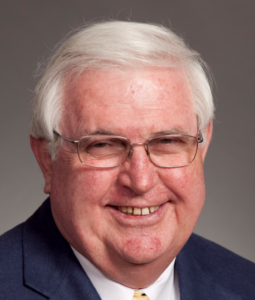 Reservoir Characterization by Production Data
Reservoir Characterization by Production Data
Dr. Larry Lake, professor in the Department of Petroleum and Geosystems Engineering at The University of Texas at Austin, will deliver a Distinguished Lecture at BYU at 4:00 p.m. on January 22, 2015. This will be followed at 6 p.m. by a dinner meeting with presentations of ongoing research by BYU students. The seminar will be held in room CB 254 of the Clyde Engineering Building at Brigham Young University in Provo, UT. The dinner meeting will be held in the Wilkinsons Center, also at BYU. Please RSVP to Landon Paskett, landon.paskett@byuspe.com, for either or both events by January 15, 2015. The seminar is complimentary (no charge) and the cost for the dinner is $25 for SPE members and $15 for members of an SPE student chapter. Requests for dietary constraints should be indicated. Maps and instructions for parking are appended to this announcement.
Larry W. Lake is a professor in the Department of Petroleum and Geosystems Engineering at The University of Texas at Austin. He holds B.S.E and Ph.D. degrees in Chemical Engineering from Arizona State University and Rice University, respectively. Dr. Lake is the author or co-author of more than 100 technical papers, four textbooks and the editor of three bound volumes. He has served on the Board of Directors for the Society of Petroleum Engineers (SPE), won the 1996 Anthony F. Lucas Gold Medal of the AIME, the Degoyer Distinguished Service Award in
2002, and has been a member of the National Academy of Engineers since 1997
Abstract for Distinguished Lecture by Dr. Larry Lake
The history of reservoir characterization has been based on and currently rests on static data. Indeed, entire technologies, academic majors, and even commercial enterprises have sprung up to gather, interpret, and use core data, logs, geology and seismic data. The saturations, porosities, permeabilities, relative permeabilitiies, to name a few, from these technologies form the basis of volumetric calculations (original hydrocarbon in place), and recovery estimates (recoverable hydrocarbon).
Ironically, it is dynamic data or data from flowing wells that are of commercial interest because revenue streams are directly proportional to it. But, aside from use in pressure transient analysis and as targets in simulation history matching, these data are little used in characterization.
This situation is about to change. The large-scale use of near-continuous (real-time) surface and downhole measurements of rates (all fluids), pressures, and temperatures will augment and in some cases supplant reliance on static measurements. Such measurements are common now on new production facilities. Indications are that they are cost-effective on existing or legacy production.
But these measurements will only be useful if there are means to interpret them. The objective of this presentation is to discuss the capacitance-resistance model that will use the coming “tsunami” of data to characterize reservoirs.
Agenda
4:00 – 5:00 p.m. Lecture by Prof. Larry Lake, University of Texas at Austin Clyde Engineering Building
CB 254
6:00 – 8:30 p.m. Dinner Meeting and Student Presentations
• Ammon Eaton:
• Reza Asgharzadeh (Junho Park):
• Abe Martin:
• Sarah Nikbakhsh: Wilkinsons Center
WSC 2142
Directions and Parking Instructions
Approaching from Salt Lake City
If attending for the 4 pm lecture
1. Take I-15 southbound
2. Take exit 269 in Orem towards University Parkway. Follow University Parkway eastbound for 4 miles until you approach the football stadium
3. University PARKWAY becomes 1650 North St. as you pass over University AVENUE. Continue on E 1650 N St. for half of a mile, passing the football stadium on the left and baseball fields on the right.
4. Right turn onto 900 East Street. Continue for half of a mile.
5. Right turn on 1100 North Street. Continue 500 ft.
6. Park in Visitor Parking on the left. Address: E 1100 N St, Provo, UT 84604. Walk to the Clyde Building on the southeastern corner of campus (see blue arrow below).
If attending for the dinner only
Follow the same directions as above, but after parking, walk according to the green arrow below to WSC 2142 in the Wilkinsons Center